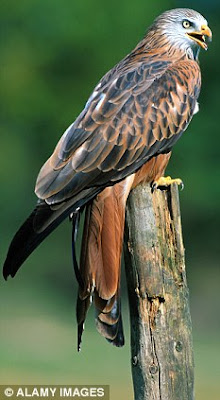By JONATHAN PETRE AND VALERIE ELLIOTT Flying high: Back from the brink of extinction, the red kites are flourishing across Britain
Flying high: Back from the brink of extinction, the red kites are flourishing across Britain
In Victorian times they were treated like vermin and hunted to the brink of extinction.
But red kites are once again flourishing across Britain, thanks to the efforts of conservationists...and local councils who leave household rubbish to pile up.
The birds of prey are natural scavengers, and experts believe the growing amount of food thrown away, combined with less frequent bin collections, is helping the species thrive.
In Reading up to 60 red kites have been spotted from the roof of a multi-storey car park, apparently watching for the roadkill on which they like to feed.
Earlier this month, BBC1’s The One Show featured a flock attracted to the waste left at a roadside cafe in Oxfordshire, and there have also been sightings in Leeds, Gateshead, Manchester, Birmingham, Coventry and Hampstead and Hackney in North and East London.
Despite the efforts of conservationists, the numbers of red kites plunged to just a handful of breeding pairs in the 1960s, confined to rural mid-Wales.
But a concerted reintroduction programme begun 20 years ago means that there are now thought to be 1,800 breeding pairs across the country.
In medieval times, red kites proliferated in Britain.
By snatching discarded food from the streets, they helped keep towns and cities clean – and kites were protected by a Royal decree, with the death penalty for killing one.
William Shakespeare wrote about their habit of stealing laundry to adorn their nests, and they are known to have carried away dolls, teddy bears and toy cars.
However, by the 16th Century, kites were considered vermin, with a bounty placed on their heads.
By the 1890s, they had been virtually wiped out by landowners who wrongly believed they killed their lambs.
But in the early 1990s, the RSPB released a batch of red kites into the wild in the Chilterns, the first of several such reintroductions across Britain.
 Soaring again: A red kite spotted over houses near Slough in Berkshire. Up to 60 have been seen in Reading
Soaring again: A red kite spotted over houses near Slough in Berkshire. Up to 60 have been seen in Reading
One of the sites used was the Buckinghamshire estate of the late American-born multi-millionaire Sir Paul Getty, who hired security guards to protect nests from egg collectors.
Wildlife experts said red kites are drawn to cities because they do not like live prey.
Grahame Madge from the Royal Society for the Protection of Birds said: ‘The red kite is a scavenger, not a hunter, and the birds will gather to feed on carrion, mainly dead rabbits, mice and pheasant, and animals killed on the road.
‘They are not the fearsome predators that people in the Victorian era thought them to be and they are not like a sparrowhawk or kestrel, which would go for a live prey.
‘There have been complaints about red kites attacking dogs and cats but I think these would be very occasional instances.’
 Experts believe the growing amount of food thrown away, combined with less frequent bin collections, is helping the red kite species thrive
Experts believe the growing amount of food thrown away, combined with less frequent bin collections, is helping the red kite species thrive
John Bryant, an urban wildlife expert, said that the amount of food thrown away by families was fuelling the wildlife invasion.
‘The problem is that we’ve got all these bin bags that are raided at night by foxes, rats and squirrels, then the contents are strewn on streets and in gardens,’ he said.
‘Red kites are scavengers and it is not surprising they are also now being spotted in towns.
‘If wheelie bins are too full because the rubbish is not collected as frequently as it once was, people will leave black bags on top or put them inside but not close the lid, so the wildlife can still get at them.
‘In some areas, people are expected to leave black bin bags in the street to be collected. That is an invitation to scavengers.’
source: dailymail
Saturday, February 26, 2011
Vermin...or awesome bird of prey? The red kite is back in British towns
 7:29 PM
7:29 PM
 Animal news
Animal news


0 comments:
Post a Comment
Note: Only a member of this blog may post a comment.